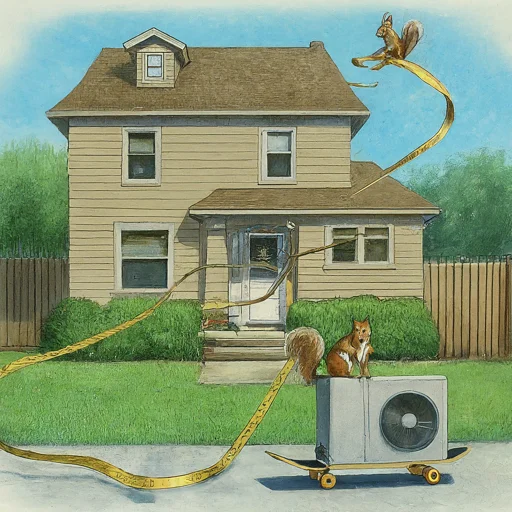How Far Can I Move My AC Unit?
Relocating an air conditioning (AC) unit is not a trivial task and involves several considerations to ensure the system operates efficiently and safely. Whether you’re moving a central air conditioning unit or a window unit, understanding the limitations and requirements is crucial.
We will explore the factors involved in moving an AC unit, how far you can move it, and the steps you need to take to do it correctly.
You'll Learn About
Types of AC Units

1.1 Central Air Conditioning Units
Central air conditioning systems consist of an outdoor unit (condenser) and an indoor unit (evaporator coil) connected by refrigerant lines. The distance between these units is determined by the length of the refrigerant lines.
1.2 Window Air Conditioning Units
Window AC units are typically installed in a window or a hole in a wall. These units are self-contained and don’t have separate components connected by refrigerant lines.
1.3 Mini-Split Systems
Mini-split systems, or ductless systems, have an outdoor condenser and one or more indoor air handlers. Similar to central AC units, the indoor and outdoor units are connected by refrigerant lines.
Factors to Consider When Moving an AC Unit

2.1 Refrigerant Line Length
For central and mini-split systems, the refrigerant line length is a critical factor. Most manufacturers specify a maximum line length that ensures efficient operation. Exceeding this length can lead to reduced efficiency, increased wear and tear, and potential damage to the compressor.
Typical maximum refrigerant line lengths:
- Central AC Units: Up to 100 feet, though many systems recommend keeping it under 50 feet.
- Mini-Split Systems: Varies by model, typically between 50 and 100 feet.
2.2 Electrical Considerations
When moving an AC unit, you’ll need to ensure that the electrical wiring is adequate for the new location. Also, splice wire carefully. This includes checking the length and gauge of the wires and ensuring that they meet local electrical codes.
2.3 Drainage
Proper drainage is essential for the operation of an AC unit. When relocating a unit, you need to ensure that the condensate drain can properly remove water from the system. This might require extending or rerouting the drain line.
2.4 Permits and Regulations
Local building codes and regulations might require permits for relocating an AC unit. It’s essential to check with local authorities to ensure compliance.
2.5 Professional Help
Given the complexity and technical requirements involved in moving an AC unit, hiring a professional HVAC technician is highly recommended. They have the expertise to handle refrigerant lines, electrical wiring, and ensure that the system operates efficiently after the move.
Steps to Move an AC Unit
3.1 Planning
- Assess the New Location: Ensure the new location meets all requirements for clearances, ventilation, and accessibility.
- Measure Distances: Measure the distance between the current location and the new location to determine if it falls within the acceptable range for refrigerant lines and electrical wiring.
3.2 Shutting Down the System
- Turn Off the Power: Ensure that the power to the AC unit is turned off at the breaker box.
- Recover the Refrigerant: An HVAC technician will need to recover the refrigerant from the system to prevent release into the environment.
3.3 Disconnecting the Unit
- Disconnect Refrigerant Lines: Carefully disconnect the refrigerant lines from the unit.
- Disconnect Electrical Wiring: Disconnect the electrical wiring, ensuring to label the wires for reconnection.
- Disconnect Drain Line: Disconnect the condensate drain line.
3.4 Moving the Unit
- Transporting the Unit: Carefully move the unit to the new location, ensuring that it is handled properly to avoid damage.
3.5 Reconnecting the Unit
- Reconnect Refrigerant Lines: Connect the refrigerant lines to the unit. This step requires precision to avoid leaks.
- Reconnect Electrical Wiring: Connect the electrical wiring according to the labels made during disconnection.
- Reconnect Drain Line: Ensure the drain line is properly routed and connected.
3.6 Testing the System
- Evacuate and Recharge Refrigerant: The HVAC technician will evacuate the system to remove any air and moisture, then recharge it with the correct amount of refrigerant.
- Test for Leaks: Check all connections for leaks.
- Start the System: Turn on the power and test the system to ensure it operates correctly.
Maximum Distance Between AC Compressors
The maximum distance between AC compressors plays a critical role in determining the efficiency and performance of an air conditioning system.
By keeping the indoor and outdoor units within close proximity to each other, coolant flow is optimized, pressure drop is minimized, and cooling capacity is maintained.
Installers and homeowners should prioritize adherence to manufacturer guidelines and proper installation practices to ensure reliable and efficient operation of their air conditioning equipment.
Importance of Proximity
Efficient Coolant Flow
Maintaining a close distance between AC compressors is essential for optimizing the flow of coolant within the system. When the indoor and outdoor units are situated closer together, the refrigerant can circulate more effectively, resulting in improved cooling performance and energy efficiency.
Minimized Pressure Drop
Reducing the distance between compressors minimizes the pressure drop experienced by the refrigerant as it travels through the system. This ensures that the refrigerant reaches its destination with sufficient pressure to facilitate the heat exchange process, enhancing the overall cooling capacity of the air conditioning system.
Impact on Cooling Efficiency
Reduced Cooling Capacity
When the indoor and outdoor units are separated by a distance greater than the recommended maximum of 15 meters, the cooling efficiency of the air conditioning system is significantly compromised.
Longer refrigerant lines result in increased friction and resistance, leading to diminished cooling capacity and potentially uneven temperature distribution within the conditioned space.
Energy Consumption
A greater distance between compressors not only affects cooling performance but also increases energy consumption. The compressor must work harder to overcome the additional resistance in the refrigerant lines, resulting in higher energy bills and potentially reducing the lifespan of the equipment due to increased wear and tear.
Installation Considerations
Planning for Optimal Placement
During the installation process, careful consideration should be given to the placement of both the indoor and outdoor units to ensure they are within the recommended distance of each other. This may involve positioning the units strategically and minimizing the length of refrigerant lines to maintain proximity.
Utilizing Proper Sizing
Selecting appropriately sized refrigerant lines is crucial for minimizing pressure drop and optimizing coolant flow between compressors. Oversized or undersized lines can lead to inefficiencies and may require additional measures, such as insulation or line set enhancements, to mitigate potential issues.
Compliance with Manufacturer Guidelines
Adherence to Manufacturer Specifications
Following the guidelines provided by the manufacturer of the air conditioning equipment is essential to ensure optimal performance and reliability. Manufacturers typically specify the maximum allowable distance between compressors based on design considerations and performance testing.
Warranty Considerations
Deviation from manufacturer recommendations regarding compressor spacing may void warranties or limit coverage for repairs and replacements. It is important for installers and homeowners to adhere to these guidelines to maintain warranty protection and avoid potential liability issues.
Conclusion
Moving an AC unit involves careful planning and consideration of various factors, including refrigerant line length, electrical requirements, drainage, and local regulations.
The distance you can move your AC unit largely depends on these factors, particularly the maximum allowable length of the refrigerant lines.
It is highly recommended to hire a professional HVAC technician to handle the relocation process to ensure it is done safely and efficiently. By taking the necessary precautions and following the correct procedures, you can successfully move your AC unit and maintain its performance and longevity.

